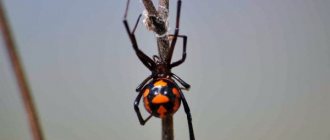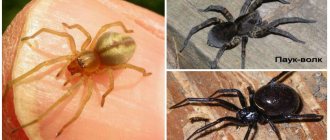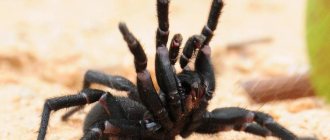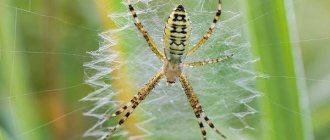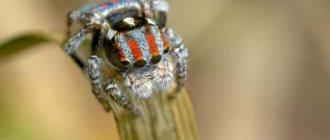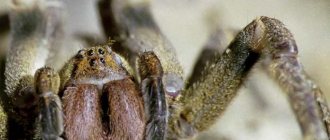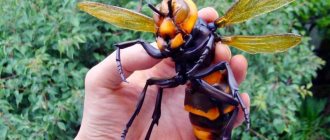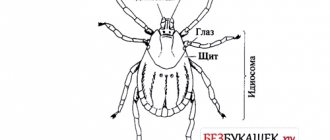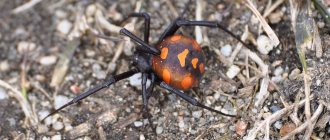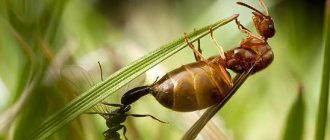According to various sources, the order of spiders numbers from 20 to 40 thousand species. All of them are poisonous, with a few exceptions, but only a few pose a danger to humans.
It is worth noting that even the bites of the most poisonous spiders are usually “empty” and do not cause harm to health. The toxicity and amount of poison is designed to infect small insects and animals.
Based on their effect on the body, spider venoms can be divided into two categories:
- Necrotic - cause damage to cells and tissues, externally manifested in the form of rashes, blisters, ulcers. In rare cases, gangrene develops.
- Neurotoxic - affect the nervous system, interfere with the transmission of signals by nerve cells or stimulate them. In extreme cases, they can cause respiratory and cardiac arrest.
In some species, the venom may contain both necrotic and neurotoxic components. An infection that can enter the body through a bite and an allergic reaction are also dangerous.
Sydney leukoweb spider
Atrax robustus (Sydney leukoweb spider) is the most venomous spider in the world. It is included in the Guinness Book of Records. This is one of the few species of spiders that can kill a person with poison:
- The spider lives in Australia, mainly in the state of New South Wales. Often found around Sydney.
- Has a black or brown color.
- Its length can reach 5 cm, and the largest individuals are 10 cm.
The spider's diet consists of large insects and other arachnids. Atrax robustus is dangerous for humans because it has a very strong poison and this species weaves webs in residential buildings, which increases the chance of residents encountering a spider. The arthropod immediately attacks if it believes that there is a threat to it.
Sydney leucopaweb spider: Wikipedia
Determine the location of the bite by fang marks and a strong burning sensation. The spider bites tightly into the victim and can bite several times, introducing more and more poison. After a bite, symptoms appear almost immediately, which progress and can be fatal:
- salivation:
- muscle spasms;
- difficulty breathing;
- confusion and disorientation.
Without immediate medical attention, a person may lose consciousness and die. Since the invention of the antidote in 1981, no deaths from Atrax robustus venom have been recorded.
Northern tree funnel-web spider (Hadronyche formidabilis)
This is the largest representative of funnel-shaped spiders with a body length reaching 4–5 cm. It lives in Australia on fallen trees, in hollows and crevices of the bark, for which it received the name “arboreal”. This is the only arachnid in the top 10 that is attracted to water. Australian homeowners often catch an arachnid that has fallen into the water and end up being bitten.
View this post on Instagram
A post shared by Victor Ray (@v1cr4v)
The venom of the tree funnel-web spider is potentially fatal to humans and is one of the most toxic. However, only 8 bites have been reliably recorded in the world. Symptoms of poisoning appear within 15–20 minutes. The bite is accompanied by pain, muscle spasm, tachycardia, and increased sweating. The person feels sick and falls into an altered state of consciousness.
Brazilian wandering spider
The Brazilian wandering spider is a dangerous spider from the runner family. Lives in the tropical part of South America.
The main danger to humans is the neurotoxin PhTx3, which is synthesized by arthropods. The poison quickly spreads throughout the human body and makes it impossible to control muscle function. Without timely medical attention, neurotoxins lead to cardiac arrest, paralysis or suffocation.
Brazilian wandering spider: Wikipedia
An effective antidote has been developed for the venom of the Brazilian spider, so the number of victims is approaching zero.
Mouse spider
Mouse spiders (lat. Missulena) are spiders from the family Actinopodidae. A total of 11 species are known. Ten of them are considered endemic to Australia, the 11th species (lat. Missulena tussulena) lives in Chile. They got their name (English: mouse spiders) due to the erroneous idea that they supposedly dig deep holes like mice.
flickr/Volker Framenau
Mouse spiders prey on insects and other spiders. In addition, they themselves are food for wasps, scorpions, labiopods and bandicoots. The venom of this spider is protein in nature and is considered dangerous to humans. Fortunately, they are rarely found near human habitation.
Black Widow
Black widow is a type of poisonous spider. It is dangerous for humans. You can recognize an arthropod by its black body. Females have a red, hourglass-shaped spot on their abdomen.
The spider is common in South and North America. Its size does not exceed 10 mm in females and 4 mm in males.
Black Widow: Wikipedia
The diet is based on small insects, centipedes and other spiders. The spider got its name because after mating the female often eats the male.
The black widow is the first to show no aggression towards humans. It can bite only in a hopeless situation. The spider's venom contains neurotoxins and quickly spreads through the victim's lymphatic system. As National Geographic notes, it leads to painful cramps, especially in the abdominal area. With timely treatment, a spider bite does not pose a threat to humans.
Brown Widow
Like its brethren, the brown widow produces a neurotoxic venom that can cause a variety of symptoms known as latrodectism.
The Brown Widow has relatively thin legs and a deep, spherical abdomen. On the abdomen there are one or more red spots on the top or bottom. The spots may be shaped like an hourglass or several dots. Males are much smaller than females and less dangerous, but they can also bite.
Brown widow venom causes painful effects including muscle spasms, "tetanus" contractions, and in rare cases, spinal or cerebral palsy. It is usually temporary but can cause permanent damage to the central nervous system. The effects of the bite may require a short hospital stay. Children, elderly and sick people are more likely to suffer serious consequences.
Karakurt
Karakurt is a poisonous spider from the genus of black widows. The name of the spider goes back to the Turkic phrase 'black insect'. The Latin name of the spider Tredecimguttatus accurately conveys its appearance - the arthropod has thirteen spots on the upper part of the abdomen.
Karakurts live in Central Asia, including the deserts of Kazakhstan, Southern Europe and North Africa. The natural enemies of these spiders are hedgehogs and wasps.
Karakurt: Wikipedia
Karakurt will not be the first to attack a large animal or person, but will attack if disturbed. The arthropod's bite contains neurotoxins that immediately begin to act. Signs of poisoning with karakurt poison are:
- sharp tension in the abdominal muscles;
- displacement of the eyeball;
- nausea, dizziness, increased heart rate;
- depression.
The victim should be immediately taken to the hospital for the administration of a special serum. Livestock farming often suffers from karakurts, camels and horses are especially vulnerable.
Tarantula spider
The tarantula spider is a poisonous spider of the tarantula family. The size of individual individuals can reach 28 cm.
Its habitat covers the entire Southern Hemisphere, as well as part of the Northern Hemisphere. Tarantulas can live both in humid equatorial forests and in arid regions.
Tarantula spider: Wikipedia
Despite the name, the main diet of tarantulas is not birds. Tarantula spiders are predators; they feed on:
- large insects;
- small freshwater and rodents;
- fish.
A spider bite is extremely unpleasant, but poses no danger to a healthy adult. The tarantula's venom causes severe pain, fever, convulsions and increased body temperature.
For allergy sufferers, children and pets, the poison poses a serious danger, even death. In any case, medical or veterinary care is required for a tarantula bite.
Six-Eyed Sand Spider
The six-eyed sand spider is a venomous spider of the Sicarius family. Distributed in South Africa, prefers desert or semi-desert areas. The spider has a fairly large body of a yellowish color.
Six-eyed sand spider: Wikipedia
The poison is dangerous for humans due to its pronounced necrotic effect. It quickly spreads throughout the body and affects tissues, causing them to die. In addition, the poison can destroy red blood cells, causing oxygen starvation of the body and death. However, there are only a few confirmed cases of death from sand spider bites.
Six-eyed sand spider
The six-eyed sand spider (lat. Sicarius hahni) is considered one of the most dangerous spiders. Lives in South America and southern Africa. Sets up ambushes, hiding in the sand. It attacks the victim with lightning speed, injecting its deadly poison into it. They prefer to hide among sand dunes, under stones and snags or tree roots.
flickr/markusOulehla
Most often, these spiders themselves avoid meeting people, but if given the chance, they will definitely bite. They are among the five most dangerous spiders on our planet. The toxin in the venom of the six-eyed spider causes ruptures in the walls of blood vessels, which leads to serious internal bleeding. An antidote has not yet been found, but despite this, only two cases are known in which people died from the bite of these spiders.
Tarantula
Tarantulas are a genus of spiders from the wolf spider family. These are large poisonous spiders, averaging 10 cm in size. Tarantulas live in steppes, deserts and semi-deserts.
The main time of activity and hunting is after sunset. The spider does not weave hunting nets, so a poisonous bite is the only way to hunt. Most often, tarantulas feed on large insects.
Tarantula: Wikipedia
A tarantula bite is not fatal to a healthy adult, but does cause swelling. If a tarantula attacks, consult a doctor. This type of spider can easily be confused with the more dangerous larger spiders.
The Tarantella dance is named after tarantulas: it was believed that only energetic dance movements could save a person from the serious consequences of an arthropod bite.
Yellow sac spider
Cheiracanthium, or yellow-sac spider (lat. Cheiracanthium) is a poisonous spider from the family Miturgidae. It lives almost throughout Europe, but is quite rare, as it is very shy and tries to avoid meeting people. They usually hide in leaves rolled into a tube.
flickr/mcvmjr1971
Its venom is considered the most toxic among all European spiders. After being bitten by a yellow spider, you may experience nausea and headache for several days. You can only get a bite from this spider by accident - through negligence. The European species of these spiders are not dangerous, but after a bite from the southern species, non-healing abscesses remain for a long time.
Yellow sac spider
The yellow sac spider is a poisonous species of spider that poses some danger to humans. The species was discovered in 1789.
Its habitat is wide - from Central Europe to Central Asia. A large number of spiders are found in Germany. In Kazakhstan, there is a high chance of meeting a spider in the Karaganda region. It has a light color, its body length is about 15 mm.
Yellow sac spider: Wikipedia
Females can show aggression towards humans, protecting their offspring, even if he passes by the place with the cocoon. In other cases, the spider can bite only for the purpose of self-defense.
The bite causes discomfort, vomiting, dizziness, and muscle spasms. Symptoms may last up to three days. With timely medical care there is no threat to life.
Spider mouse
The mouse spider (Missulena) is a venomous spider of the family Actinopodidae. It got its name due to the mistaken belief that it is capable of digging deep holes for itself.
The mouse spider is common in Australia and Chile. Its size can reach 3 cm. Females and males differ greatly in color.
Spider mouse: Wikipedia
Spider venom is dangerous to humans, but bites rarely lead to serious consequences. The spider is supposed to bite a person without injecting venom.
Research by Australian scientist Geoffrey K. Isbister showed that forty cases of human mouse spider bites have been identified in Australia. Of these, only one case of serious poisoning of a one and a half year old child. Local neurotoxic effects were observed in six cases, and minor effects in five. There were no reported deaths.
Redback spider (Latrodectus hasselti)
The red-backed spider is originally from Australia, but along with the export of grapes it has already spread to New Zealand, Belgium, and Japan. Judging by the speed of spread, it can also be found in countries far from its habitat, such as Ukraine, Russia or Belarus. Unlike other species, it settles in cities. You can recognize the redback spider by its distinct red stripe on its back. The marking is more noticeable on females than on males.
View this post on Instagram
A post shared by Victor Ray (@v1cr4v)
The spider is not aggressive, but the female will attack if her eggs are disturbed. The venom is a mixture of neurotoxins called alpha-latrotoxins. Causes pain, sweating, increased heart rate and swollen lymph nodes. The spider is able to regulate the amount of venom injected depending on how hard it is pressed.
Every year in Australia, up to 250 people seek medical help after being bitten. Doctors' opinions regarding the antidote vary. Today it is believed that the antidote does not relieve symptoms or relieve pain. However, the last recorded death from a redback spider bite occurred in 1956.
Recluse spider
The brown recluse spider is a dangerous spider species for humans. It lives in the southeastern United States. The body size is 1–2 cm, the color is brown and black. On the cephalothorax there is a pattern characteristic of the species, resembling a violin. The recluse spider has six eyes.
Loxosceles reclusa is a nocturnal hunter that comes out to hunt at sunset. Its prey is insects and other spiders. The recluse spider is not aggressive towards humans, but can bite in self-defense.
Recluse spider: Wikipedia
Spider venom in large doses causes tissue necrosis and leads to the formation of a necrotic ulcer. In most cases, the spider injects small doses of venom, which provoke unpleasant symptoms - nausea and fever.
The most dangerous spiders on the planet have strong poison. A person is of no interest to them as a source of food, so he rarely becomes an object of attack.
However, the bites of these arthropods, which are committed mainly for the purpose of self-defense, can be painful. Without special medical care, in some cases a person may die.
Original article: https://www.nur.kz/leisure/interesting-facts/1775167-samye-opasnye-pauki-na-planete/
Wolf spider (Lycosidae)
Wolf spiders are a common group of arachnids, which includes 2367 species, grouped into 116 genera. Obviously, most wolf spiders are not dangerous to humans. Arachnids hunt beetles and regulate populations of flies and other insects.
View this post on Instagram
A post shared by Victor Ray (@v1cr4v)
The wolf spider attacks the victim while jumping. However, the group received its name not from its hunting method, but from the early belief of entomologists that this arthropod hunts in a pack, like wolves.
The spider is known for its high running speed and the fact that it builds a nest in rodent burrows, between stones. It can settle in a person’s home if it finds suitable shelter. Not considered aggressive, but will attack if accidentally caught between two surfaces, such as a palm and a wall. If a bite occurs, ice is placed on the bitten area to reduce swelling. And then you should seek medical help.
